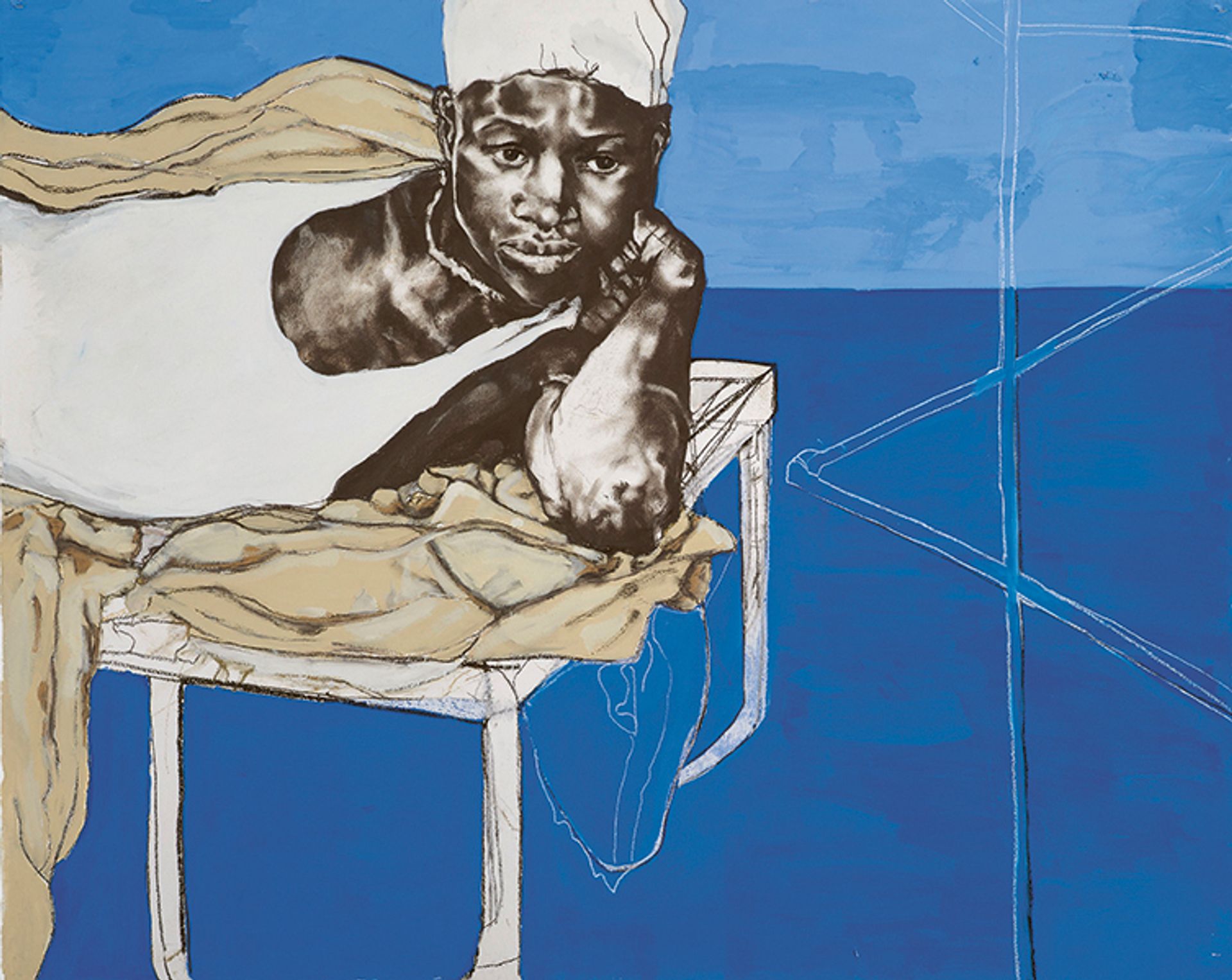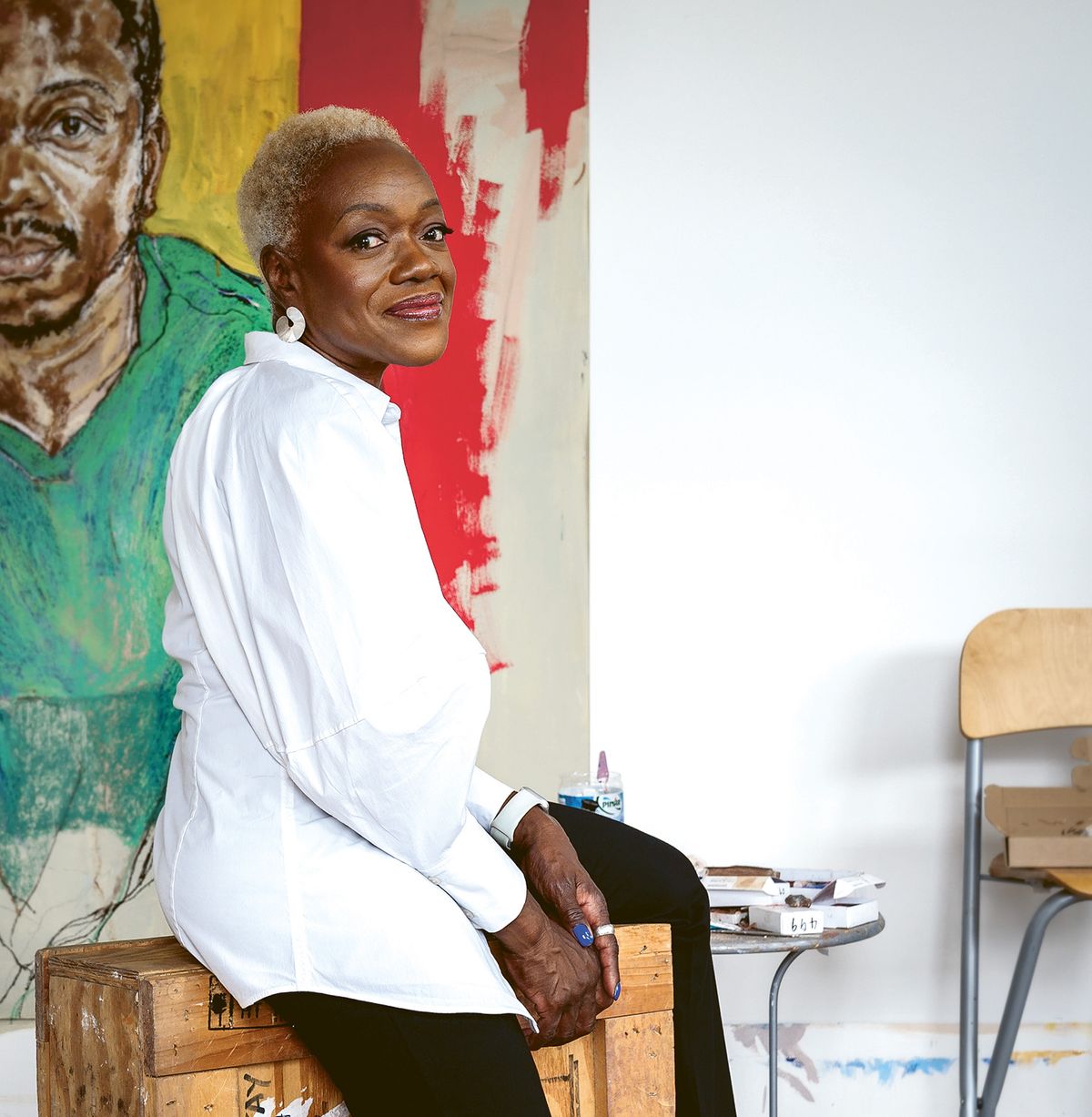Claudette Johnson has created some of the most powerful figurative art of recent decades in Britain. Since the early 1980s, she has used drawing and painting together in works that are bold yet sensitive, imposing in scale and intimate in their handling. They confront the historic invisibility, distortion and denial of Black subjects—and particularly Black women—in art.
Born in 1959 in Manchester, and now living in London, she studied at Wolverhampton Polytechnic where she was part of the Blk Art Group with artists including Marlene Smith and Keith Piper. Infamously, her presentation on her work at the first National Black Art Convention at Wolverhampton in 1982 prompted a debate that precipitated a gathering of women artists, triggering a series of now legendary shows instigated by and featuring Lubaina Himid, Sonia Boyce, Ingrid Pollard and others, who, like Johnson, have only recently received due attention. After a period in which she barely showed her work between the 1990s and 2010s, in recent years Johnson has shown widely to much acclaim. Her first major museum presentation in London, featuring works ranging from her 1980s “semi-abstract” pieces to a new painting, is now open at the Courtauld Gallery.
The Art Newspaper: You have a show at the Courtauld. Inevitably, there’s an element of its history that must creep into your thinking. Has that been something that you’ve enjoyed? Exhibiting in spaces that are full of historic masterpieces can be a weighty experience.
Claudette Johnson: Yes, I have been curious about how the work will sit alongside the venerable collections that they have. There’s lots of work there that I love: Van Gogh and Lautrec, of course, and Gauguin. I have speculated about how the work will be read in that space, whether it feels as though there’s a conversation between work made with a gap of 120 or 150 years. But it feels very exciting to me that that is happening, that we’ve arrived at a moment where somebody thinks it’s an interesting thing to do to put my work in that setting.

Kind of Blue (2020) reflects the recent shift in Johnson’s practice to include Black men among her subjects Photo: Andy Keate; © Claudette Johnson; Image courtesy the artist and Hollybush Gardens, London
Your works often feature relatively unresolved or open passages. You’ve explained that with these elements you were “putting Black bodies together again in the work but reflecting the discontinuities in our histories”. Can you explain more?
That quote refers to a work from 1982, I Came to Dance, and is about the role of dance in its positive and negative senses for Black people in terms of our history. I wanted to make a drawing where the spaces reflected that history as much as the line and developed areas. I have an idea about working with images of Black people that is concerned with the difficulty of telling something that might seem like a continuous or whole story; I don’t know how to do that and I don’t have that history myself. The work reflects the gaps that I feel I had in my own history, as well as those that, in a broader sense, most diasporic Black Caribbean people have, too.
When you talk about space, are you talking about it in the broad associations of that word—societal space, historical space, as well as pictorial space?
Yes, I knew straight away that my drawings of Black people were not going to feature furniture or references to their lifestyle in terms of housing or location, because I really wanted to centre things on the body itself, and tell as much of a story as I could with the body.
From the start, there were radical gestures—forms that cut through the works.
Works like And I Have My Own Business in This Skin (1982) or Woman with Earring (1982) or I Came to Dance were driven by an opening line or a closing line. Sometimes I would begin by choosing to make a line that maybe bisected the area and then I would build the figure out of that line. At other times—with works like And I Have My Own Business in This Skin—the line that bisects the figure came right at the end and was just a freeing moment of realising I could exaggerate what was happening in the body with this single, jagged line. Some of the inspiration for that came from Picasso’s Les Demoiselles d’Avignon (1907). The way he’s breaking space in that work was inspirational for me. When I went to New York earlier this year, I saw Les Demoiselles for the first time in real life—saw the scale and the colour—and phew, it still does something to me.
You’ve described the first time you saw it in reproduction in your second year at Wolverhampton as a critical moment in terms of those semi-abstract works.
Yeah, I definitely felt: “I don’t have to work from life, I can work from my imagination, I can let my imagination run wild.”
In recent years, you’ve revisited it with Standing Figure with African Masks (2018) and Figure with Figurine (2019).
Yes, they probably do refer to Les Demoiselles to some extent. But I was trying to think about my relationship with West African sculpture and mask-making. I was trying to speak across that distance of my experience as a Black British woman and my interest in this Picasso work and my contact with masks in museums and in books; it’s not part of my history in the same way but there’s a charge that it has for me that becomes exciting when I bring it into contact with a live figure, in this case myself. I was trying to speak about all the different connections—that it’s a fractured dialogue, it’s slightly uncomfortable. It’s certainly unresolved for me, but I wanted to put those things in play together in the same space and see what they did.
You talked about the leap of imagination that seeing the Picasso gave you when you were a student, but were you also wary?
I was wary of Picasso, to some extent. But I should point out that when I made Standing Figure with African Masks, I was actually looking back to And I Have My Own Business in This Skin, and that was the work that had referred back more directly to Les Demoiselles. Thinking about that work and about its links to that earlier work really allows me to return to some of the things I was trying to talk about in that Wolverhampton conference when I presented my own work; I was using the form of Modernism and early Modernists but I believed I was saying something perhaps original or direct about Black female experience. And where my work departs from Picasso’s is in that I am trying to subvert that male gaze. I am trying to introduce another gaze; a Black feminist gaze, if you like.
You made a deliberate choice relatively recently to depict Black men in your work because they were increasingly “targeted and vilified”, you said. Was there a particular incident? Or was it an accumulation of relentless targeting and vilification that you were responding to?
There was a specific image that brought me into depicting Black men, which was an image I saw in a New York Times article. And I suppose it just crystallised something I’ve been thinking about for a long time, which is the vulnerability of Black men in terms of how they’re viewed by wider society. Somehow, that came into focus in a way that it hadn’t when I was younger, when I was very focused on Black women—that we needed to be heard, we needed to be visible. Whereas more recently, I feel I’ve got something to say about what’s happening to Black men and I want them to be present in the work. Someone speculated recently that maybe this was because I have two sons—young men—and I worry about them in the world, although they are doing fine. So that’s not an unreasonable assumption to make. But, again, it’s the wider political sense of what it means to represent Black male figures, and what I can bring to how I represent them that might tell a different story than the one people are used to thinking about.
• Claudette Johnson: Presence, The Courtauld, until 14 January 2024
This is an edited transcript of an interview that was recorded for our podcast A Brush With. Listen to it wherever you get your podcasts


